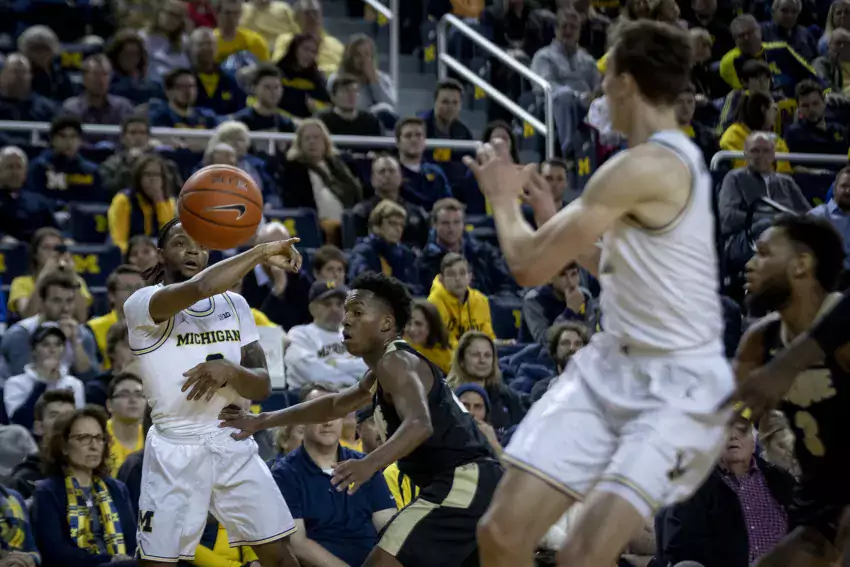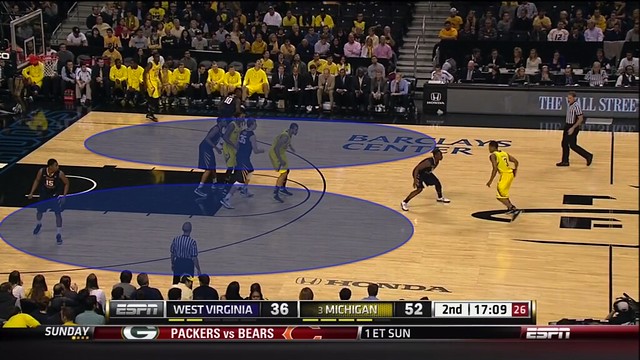spacing

1/9/2019 – Michigan 84, Purdue 78 (2 OT) – 11-4, 2-2 Big Ten
"Survive and advance" is the kind of thing people say in March after a 13 seed gives their team the business for 35 minutes and then skids to a halt just short of the finish line. As bits of conventional wisdom go, it's actually not bad. You're locked in a 68-team tournament with a bunch of opponents who are also pretty good. There's no such thing as a bad tourney win. Yes, even that one against Montana.
Michigan just played a 2 OT game in which six guys got more than eight minutes. We are in survive and advance mode. Every time Michigan poked their nose in front late your author had a thought bubble appear above his head. In it, his friend Jerry popped up, said "survive and advance!," and then muttered something about Huddersfield Town FC your author tried to ignore.
This is a comedown from annihilating Gonzaga to win Poseidon's Trident but I've mostly made my peace with it. Sugarplum dreams of this team being elite have given way to some harsh realities. Michigan is pretty short and not particularly athletic and the preseason expectations were closer to right than bouncing up to the #4 team in the country. The Big Ten is a ball of knives. We are barreling towards the first-ever NCAA tournament with Rutgers but not North Carolina.
Every game is a swing game, except one. Kenpom gives Michigan a 92% shot at beating Nebraska at home just before the season's end. They do not have an 80%+ shot in any other game. Nor do they have an insurmountable task. Games at OSU and Maryland sandwiching the Nebraska game are 26% and 29% shots. Everything else is in coinflip land. There are no bad wins from here on out, especially when Michigan is down its most efficient offensive player and one of three defensive cornerstones.
Did we win? Good. No further questions.
[After THE JUMP: Further questions!]
Trey Burke had a virtuoso performance against West Virginia on Saturday, scoring 27 points on 16 shots with eight assists, five rebounds, three steals, and no turnovers. Already the consensus choice for best point guard in the country, he's legitimately in the conversation for national player of the year honors; excise a ten-point, four-assist "dud" against Kansas State, and he's tallied either 16+ points or 7+ assists in every game this season.
John Beilein's offense is complicated, a highly-structured symphony of cuts and screens that relies largely on off-ball movement to create open looks. That is, unless it's time for Trey Burke to score. Last year's offense centered around the high ball screen to get Burke looks at the basket; while that's still a big part of the offense, Michigan is increasingly looking to isolate Burke and let him create.
The Wolverines did this in a variety of ways against West Virginia. Let's take a look at a few of them.

Michigan showed this setup a few times on Saturday. Instead of having two guards up top, Burke is alone with the ball; the 2 and the 3 (Hardaway and Stauskas) set up in the corner; the 4 and the 5 (Robinson and Morgan) form a stack at the free-throw line. This alignment leaves plenty of room on both sides of the court for Burke to maneuver. On this play, Burke doesn't even need help from a screen—he simply sets up his man with a hesitation move and drives hard to the right, netting a short bank:
The help is late-arriving because the threat of an open Stauskas or Hardaway (either in the corner or cutting to the basket) is, well, threatening. Having both bigs at the free-throw line or above draws the defense's shot-blocking threats away from the basket. A defense could try to counter this look by playing zone, but that brings forth a new set of problems, especially against a sharp-shooting team like Michigan.
Of course, for this set to be effective, a team needs a point guard who can create off the dribble and finish. This is not a problem for Michigan, obviously.
[Hit THE JUMP for more Trey Burke driving into big blue circles.]
47